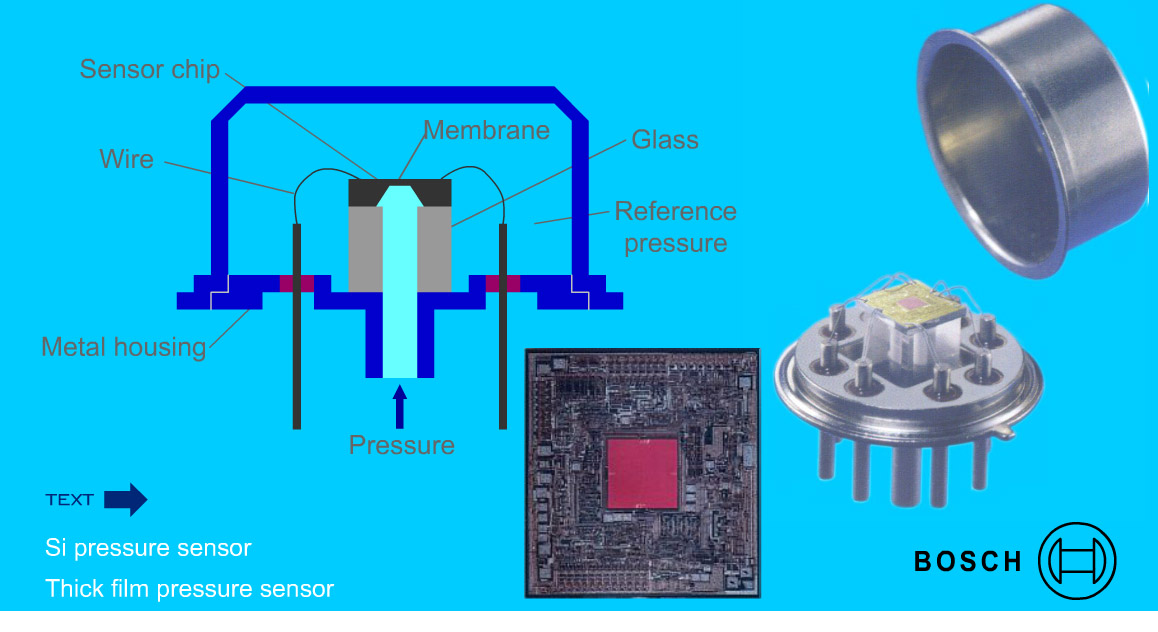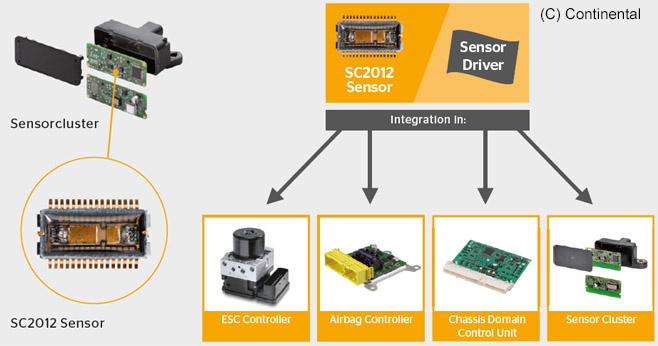
6 - Application of sensors
6.2 - Automotive sensors
Ignition systems
Knocking sensor
Pressure sensor
Piezoresistive silicon pressure sensors employ resistors as sensing elements, diffused or implanted into the surface region of a membrane made by anisotropic etching. The linearity of the sensor depends on the uniformity of the resistance values and deformations; thus, the bridge must exactly be balanced and the resistors well positioned. The temperature drift of the zero output is determined by the TCR tracking of the resistors, while the temperature dependency of the sensitivity is determined mainly by the temperature coefficient of the gauge factor (TCGF). The bridge balance adjustment is generally made by external potentiometers or by laser trimming. An analogue compensation of the temperature dependency can be achieved by connecting appropriate temperature dependent resistors between the bridge and the power supply. Digital temperature compensation can be realized by measuring the chip substrate temperature with a simple integrated pn-junction temperature sensor element. Nowadays, the chip contains a complicated compensation circuitry in order to get the same characteristics. The pressure sensor chip is generally mounted onto another silicon or glass substrate, in order to minimize the stresses due to the thermal expansion mismatch between the silicon chip and the packaging materials. This system is then mounted into metal packages. he piezoresistive thick-film pressure sensor applies a secondary resistor bridge for temperature compensation purposes.
Si based pressure sensor

Thick film pressure sensor

Air-flow sensors
The micromechanical air-flow sensor contains a thin membrane etched out of the silicon wafer using the anisotropic etching. In the middle of the membrane, a heating element is deposited, while two temperature dependent polysilicon resistors are formed on its both sides. The operation is based on the Thomson principle. Without air flow, the thermal distribution is symmetrical; otherwise a mass flow dependent temperature difference can be measured.
Lambda sensor
Accelerometer
Sensor cluster containing an accelerometer and a yaw-rate sensor. Source: Continental

Sunlight sensor
The sensor consists of an arrangement of photo diodes underneath a shadow mask. The distance between two neighboring diode pairs differs slightly from the distance between neighboring apertures in the shadow mask. The two diodes of each diode pair are series-connected in reverse bias and connected to a supply voltage. The diode exposed to higher light incidence "draws" the potential at the mutual joint in its direction. All voltages on all diode pairs considered one after another, the consequence of the offset towards the shadow mask is first a sequence of low voltages and then, from a certain diode pair on, a sequence of high voltages. The point at which the electric potential changes abruptly determines the measure for the angle of light incidence.
| Previous | Next |
